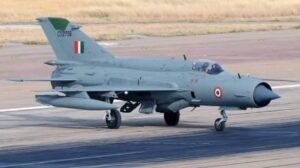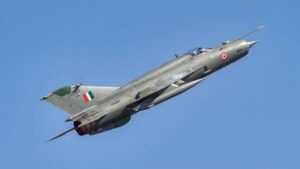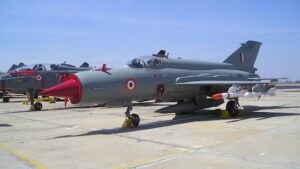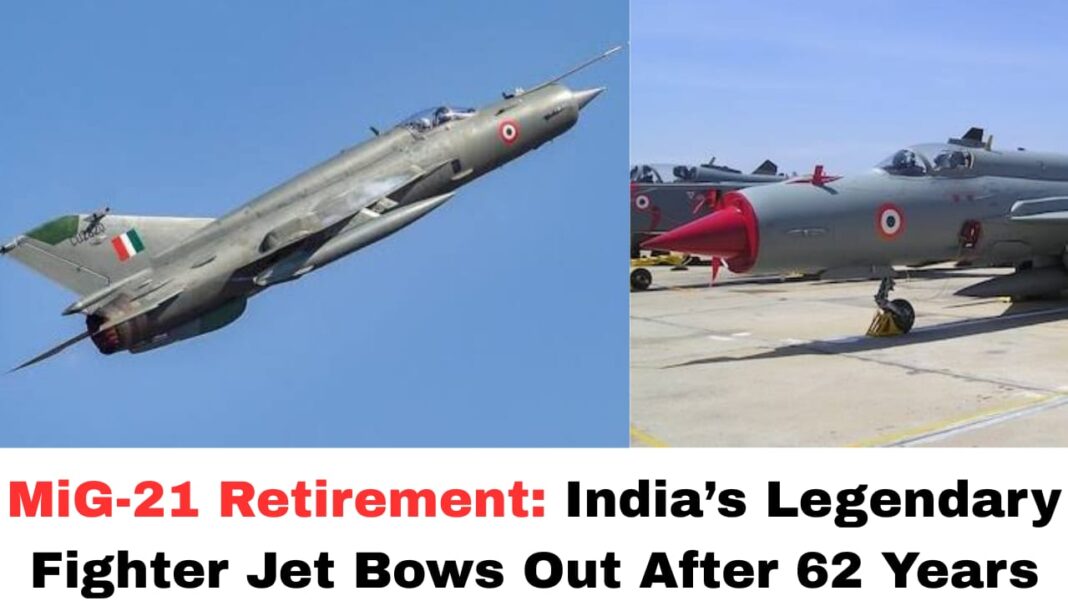Digital News Guru National Desk:
The End of an Era: MiG-21’s Final Bow in the Indian Air Force
The Indian Air Force (IAF) is set to retire the MiG-21 jets on September 26, 2025, after more than 60 years of service. A ceremonial send-off has been planned. The last remaining squadron operating the MiG-21s is No. 23 “Panthers.” Air Chief Marshal Amar Preet Singh has led final sorties in the aircraft, including flying formation with No. 23 Squadron, as a tribute.
A Storied Legacy
The MiG-21 was first inducted into the IAF around 1963. As India’s first supersonic jet fighter, it played critical roles in multiple conflicts: the 1965 and 1971 India-Pakistan wars, the Kargil conflict in 1999, and more recently in operations like Balakot in 2019.

Over time, multiple variants were deployed: Type-77, Type-96, BIS, and the upgraded Bison version. The Bison variant incorporated modern avionics, radar improvements, electronic warfare suites, improved communication systems, etc. Though upgraded many times, the basic airframe, engine, and design constraints began showing limitations in later years.
The Process of Phasing Out
Several MiG-21 squadrons have already been number-plated or re-equipped over the past years. For example:
- The No. 4 Squadron (“Oorials”) based at Uttarlai (Rajasthan) retired its MiG-21s, replacing them with Su-30 MKIs.
- The No. 51 Squadron (Srinagar) had also been phased out earlier.
By mid-2025, only two squadrons remained operational with MiG-21 Bison aircraft: No. 3 “Cobra” Squadron and No. 23 “Panthers” Squadron. These represent the final active units flying the MiG-21 platform.
The official de-induction date is set for September 26, 2025. A ceremonial farewell is scheduled earlier: a flypast, guard of honour, and formal handover of key aircraft documentation at Chandigarh airbase. The “Form 700” (maintenance / airworthiness log) will symbolically be handed over, signifying the closure of maintenance and service operations.
After the final flights, the remaining MiG-21 airframes will largely be flown to Nal Airbase in Rajasthan for technical inspection. Usable parts will be salvaged; others may be preserved in museums, memorials, or placed on public display.
Reasons Behind Retirement
Several factors converged to make the retirement unavoidable:
- Age and Safety Concerns
Over its lifespan, the MiG-21 fleet has been involved in numerous accidents. As older airframes wear out, maintenance becomes more challenging, spare parts become harder to source, and the risk of failure increases. While modernization efforts extended service life, limitations remained. - Delayed Replacement
The indigenous Light Combat Aircraft (LCA) Tejas Mk1A is meant to succeed the retiring MiG-21s. However, delays in production and delivery of Tejas have forced the IAF to keep MiG-21s running beyond their originally planned retirement timeline.
- Operational & Strategic Requirements
Maintaining squadron strength is crucial for India’s strategic posture. Phasing out one of the most numerous aircraft types had to be balanced against the need for readiness, especially given threats on multiple fronts. The IAF has had to manage the transition carefully. - Technological Obsolescence
Despite upgrades (avionics, radar, etc.), the MiG-21 cannot match performance of modern multirole fighters in terms of sensors, stealth, payload, range, and fuel efficiency. The design largely reflects 1950s-60s supersonic tech, which by now is surpassed in many respects.
What the Retirement Means for the IAF
The retirement of the MiG-21 will have several immediate and longer-term implications:
- Squadron strength dip: With the retirement of remaining MiG-21 squadrons, the IAF’s combat strength will drop to 29 squadrons, its lowest since the 1960s. This reduction is significant, coming at a time when India aims to modernize its air force.
- Transition to modern platforms: The Tejas Mk1A is expected to take over many roles of the MiG-21, along with platforms like Su-30 MKI and others. Procurement of new fighter jets and strengthening of technological readiness will be essential.
- Heritage and morale: For many pilots, ground crew, and veterans, the MiG-21 is more than just a machine. It has been a symbol of India’s growing defense capabilities. Various senior officers and experienced pilots have spoken of the emotional connections to the plane.
- Safety expectations going forward: As older aircraft retire, there will be heightened expectations for safety, rigorous engineering standards, and transparent accident investigations. Ensuring that replacement aircraft are reliable will be under public and institutional scrutiny.
Looking Ahead
As India bids farewell to the MiG-21, the next phase brings both opportunity and risk. On the opportunity side, the retiring of an ageing platform frees up resources for developing, procuring, and deploying more contemporary fighters that bring better performance, survivability, and mission capability.

On the risk side, a transition period must be managed carefully. Delay in replacements, maintaining pilot training, preserving institutional memory, and ensuring that air defence coverage doesn’t suffer are key challenges.
The scheduled decommissioning events — especially the ceremonial flypast, guard of honour at Chandigarh, the formal handing over of documentation, and final sorties — are as much about closure as they are about signaling India’s intent to modernize.
Conclusion
The retirement of the MiG-21 in September 2025 marks more than just the end of a fighter jet’s service life; it marks the closing of a chapter in India’s defence history. From helping India assert air capability in early conflicts to serving into eras of vastly different warfare, the MiG-21 has been both a tool of defence and a symbol of enduring resolve. While its flaws and risks in later years are part of its story, the IAF’s decision to finally retire the aircraft reflects India’s shift towards modernization and safer, more capable aerial defence. The skies above India will no longer echo with the roar of the MiG-21s, but their legacy will live on—in memories, museums, and in the generation of pilots who first learned to fly supersonic on those wings.
You May Also Read: Leh Violence: 4 Dead, over 50 Injured in Ladakh Statehood Protests








